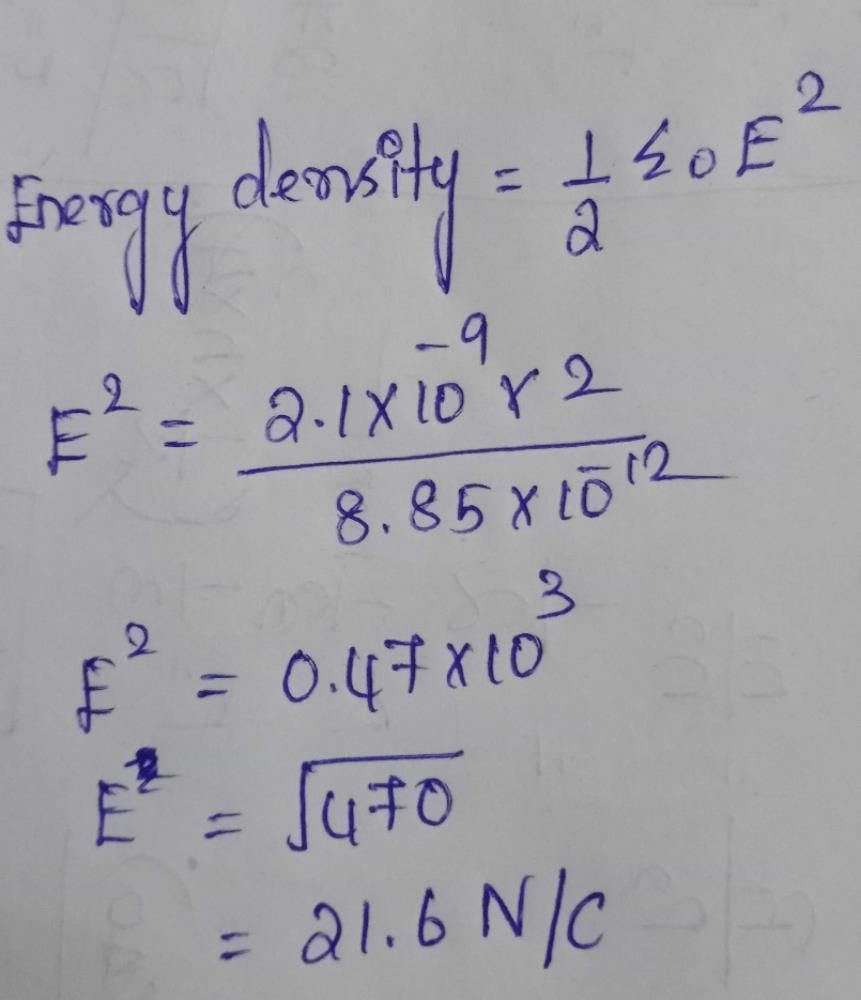NEET Exam > NEET Questions > The energy density in a parallel plate capaci...
Start Learning for Free
The energy density in a parallel plate capacitor is given as 2.1*10^-9 J/m^3.The value of electric field in the region between the plate is ?
Most Upvoted Answer
The energy density in a parallel plate capacitor is given as 2.1*10^-9...
Calculating Electric Field in a Parallel Plate Capacitor
Given Information
- Energy density in the capacitor: 2.1 x 10^-9 J/m^3
- Formula for energy density in a capacitor: U = (1/2)εE^2
- Where U is the energy density, ε is the permittivity of the material between the plates, and E is the electric field strength
- Permittivity of free space, ε0 = 8.85 x 10^-12 C^2/Nm^2
Solving for Electric Field Strength
We can rearrange the formula for energy density to solve for the electric field strength:
E = sqrt(2U/ε)
Plugging in the given values:
E = sqrt(2 x 2.1 x 10^-9 J/m^3 / 8.85 x 10^-12 C^2/Nm^2)
E = 191,770 N/C
Explanation
In a parallel plate capacitor, the electric field strength is constant between the plates and is given by E = V/d, where V is the potential difference between the plates and d is the distance between them. However, in this problem, we are given the energy density instead of the potential difference. We can use the formula for energy density, which relates the energy stored in the capacitor to the electric field strength, to solve for E. The permittivity of the material between the plates is also needed, which is typically given in the problem or can be looked up in a table.
Once the electric field strength is calculated, it can be used to find the potential difference between the plates and the charge on each plate using the equations V = Ed and Q = CV, where C is the capacitance of the capacitor. These calculations are not necessary for this problem, but may be useful in other capacitor problems.
Community Answer
The energy density in a parallel plate capacitor is given as 2.1*10^-9...

Attention NEET Students!
To make sure you are not studying endlessly, EduRev has designed NEET study material, with Structured Courses, Videos, & Test Series. Plus get personalized analysis, doubt solving and improvement plans to achieve a great score in NEET.

|
Explore Courses for NEET exam
|

|
Similar NEET Doubts
The energy density in a parallel plate capacitor is given as 2.1*10^-9 J/m^3.The value of electric field in the region between the plate is ?
Question Description
The energy density in a parallel plate capacitor is given as 2.1*10^-9 J/m^3.The value of electric field in the region between the plate is ? for NEET 2024 is part of NEET preparation. The Question and answers have been prepared according to the NEET exam syllabus. Information about The energy density in a parallel plate capacitor is given as 2.1*10^-9 J/m^3.The value of electric field in the region between the plate is ? covers all topics & solutions for NEET 2024 Exam. Find important definitions, questions, meanings, examples, exercises and tests below for The energy density in a parallel plate capacitor is given as 2.1*10^-9 J/m^3.The value of electric field in the region between the plate is ?.
The energy density in a parallel plate capacitor is given as 2.1*10^-9 J/m^3.The value of electric field in the region between the plate is ? for NEET 2024 is part of NEET preparation. The Question and answers have been prepared according to the NEET exam syllabus. Information about The energy density in a parallel plate capacitor is given as 2.1*10^-9 J/m^3.The value of electric field in the region between the plate is ? covers all topics & solutions for NEET 2024 Exam. Find important definitions, questions, meanings, examples, exercises and tests below for The energy density in a parallel plate capacitor is given as 2.1*10^-9 J/m^3.The value of electric field in the region between the plate is ?.
Solutions for The energy density in a parallel plate capacitor is given as 2.1*10^-9 J/m^3.The value of electric field in the region between the plate is ? in English & in Hindi are available as part of our courses for NEET.
Download more important topics, notes, lectures and mock test series for NEET Exam by signing up for free.
Here you can find the meaning of The energy density in a parallel plate capacitor is given as 2.1*10^-9 J/m^3.The value of electric field in the region between the plate is ? defined & explained in the simplest way possible. Besides giving the explanation of
The energy density in a parallel plate capacitor is given as 2.1*10^-9 J/m^3.The value of electric field in the region between the plate is ?, a detailed solution for The energy density in a parallel plate capacitor is given as 2.1*10^-9 J/m^3.The value of electric field in the region between the plate is ? has been provided alongside types of The energy density in a parallel plate capacitor is given as 2.1*10^-9 J/m^3.The value of electric field in the region between the plate is ? theory, EduRev gives you an
ample number of questions to practice The energy density in a parallel plate capacitor is given as 2.1*10^-9 J/m^3.The value of electric field in the region between the plate is ? tests, examples and also practice NEET tests.

|
Explore Courses for NEET exam
|

|
Suggested Free Tests
Signup for Free!
Signup to see your scores go up within 7 days! Learn & Practice with 1000+ FREE Notes, Videos & Tests.

























